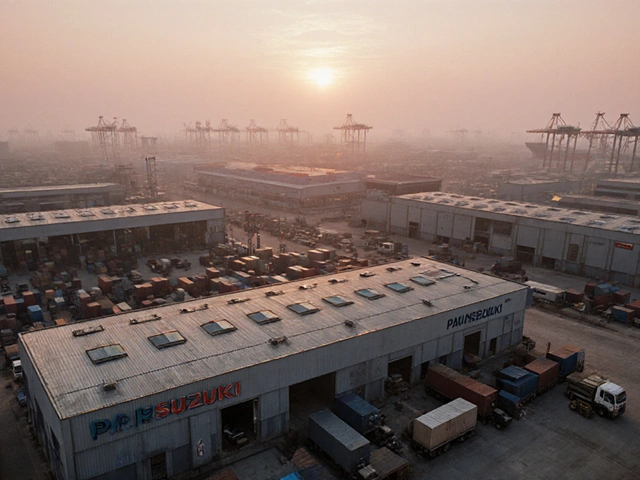Ever noticed how some products vanish from store shelves while others just gather dust? If you’re thinking about starting a manufacturing business, picking a product that’s in huge demand is the smartest move you can make—assuming you care about actually selling stuff and turning a profit.
Skip the guessing games and forget about ‘cool’ ideas your uncle swears by. You need to know what’s already moving fast in the market. For example, electric bike sales in the US shot up 23% in 2024, leaving even classic mountain bikes in the dust. And it’s not just big-ticket items—things like smart home devices and eco-friendly packaging are flying too, thanks to changing habits and new rules around sustainability.
The real trick is spotting which trends are peaking and which have solid long-term demand. If you can’t find hard numbers—real sales data, industry reports, pre-order stats—you’re basically guessing. Lots of folks lose money because they jump on ‘next big things’ right as interest tanks. That’s why it pays to stick with products people need, not just want. If you can fix daily problems or save people time and money, your product just might top the demand charts.
- Chasing Trends vs. Steady Demand
- Breakout Products in 2025
- What Makes a Product Actually Sell
- Tips for Choosing the Right High-Demand Item
- Pitfalls to Dodge When Jumping In
Chasing Trends vs. Steady Demand
If you want a manufacturing startup that actually makes money, you’ve got to decide: ride the hype wave, or build on a rock-solid foundation. Both approaches can work, but they play out way differently in the real world.
Trendy products like fidget spinners or TikTok-inspired gadgets can suddenly go viral, leading to huge sales—for a few months. When the buzz dies off, you’re left with unsold stock and a tough lesson about betting too hard on what’s currently hot. A recent study from Shopify showed that almost 65% of pop-culture products lose momentum within a year.
On the other hand, steady demand means sticking with what’s useful all the time. Water bottles, household cleaning products, or basic phone accessories never make headlines, but people keep buying them. There’s less excitement, sure, but way less risk. The market for reusable packaging, for example, grew by 17% in the past year and still looks solid because of eco trends and government rules.
Here’s a reality check:
| Type | Sales Spike? | Longevity | Examples |
|---|---|---|---|
| Chasing Trends | Huge, quick | Short-lived | LED face masks, viral gadgets |
| Steady Demand | Slow, stable | Long-term | Food containers, smart thermostats |
Going all-in on the trendiest product can make you rich fast, but only if your timing is perfect and you can clear out your inventory before people lose interest. Building around steady demand might grow slower, but your risk goes way down. Most successful startup ideas balance both: they spot trends but only jump when the data shows there’s lasting value. Think electric vehicles—huge spike, but batteries, charging gear, and parts are sticking around for the long haul.
Before you even order your first shipment, ask yourself: is this a flash in the pan, or does it solve a problem people aren’t going to stop having any time soon?
Breakout Products in 2025
If you’re looking for high demand products in the manufacturing world this year, it’s clear some things are moving way faster than others. Let’s get into the details so you know where the real action is.
Electric bikes and e-scooters are crushing it right now. U.S. bike shops reported e-bike sales hitting over $1.3 billion last year, a 23% jump from the year before. People want green transportation and cities are adding new bike lanes, pushing this trend higher for startups willing to ramp up production. Parts and accessories for e-mobility—like foldable batteries and modular frames—are also taking off, so don’t overlook those.
Another hot item? Reusable and compostable packaging. Amazon, Target, and even small brands are ditching single-use plastic. Waste regulations in Europe and parts of the U.S. are forcing businesses to go green, so anyone making eco-friendly food wraps, bags, or shipping materials is cashing in. A startup in Texas saw their compostable mailers go from 5,000 units a month in 2023 to over 60,000 a month by early 2025.
For tech fans, smart home devices are everywhere. People are grabbing AI-driven security cams, wireless thermostats, smart locks, and leak detectors. Demand is up because prices are dropping and remote work is the norm for tons of households now. In fact, 8 out of 10 U.S. households bought at least one smart device in 2024. Related add-ons—like backup batteries or privacy covers—offer easy entry for new manufacturers.
Health and wellness is still a goldmine. Demand spiked for things like ergonomic office furniture, wearable health trackers, at-home blood pressure monitors, and cold plunge tubs. Many fitness coaches are launching their own product lines, boosting the market further.
| Product Category | Growth Rate (2024-2025) |
|---|---|
| Electric Bikes & E-Scooters | +23% |
| Reusable Packaging | +32% |
| Smart Home Devices | +18% |
| At-home Wellness Devices | +20% |
Bottom line: If you’re after a startup idea that taps into what people are buying, focus on green transport, eco-packaging, smart tech, and wellness. The proof is in the sales numbers, not just the hype.

What Makes a Product Actually Sell
Here’s the thing—having a great idea isn’t enough. If you want your manufacturing startup idea to actually sell, you need a product that solves a real problem, fits the times, and beats the competition on a few key points. Let’s break it down with facts, not just opinions.
- Solving an Actual Problem: The world doesn’t need another paperweight. Look at how reusable water bottles exploded when people got tired of single-use plastics. If your product fixes a day-to-day pain point, people pay attention.
- Easy Access and Convenience: Anything that saves time or effort sells better. Take robot vacuums—they didn’t just clean floors, they freed people from a tedious chore. Think about what your idea makes quicker or easier for the user.
- Price That Feels Right: You can have the perfect product, but if your price is out of reach, demand disappears. Price matters across the board, but especially for new brands. Even niche items need to feel like a good deal compared to similar stuff.
- Trendy Doesn’t Hurt: Sometimes being first or coolest on the block gets attention. That’s why smart home devices got a boost when voice assistants became cool. Keep an eye on what’s buzzing in the news or on social media, but don’t rely on trend alone.
- Clear, Simple Value: If you can’t explain why your product matters in one sentence, it’s going to be a hard sell. People want to ‘get it’ right away. No one is reading a manual to figure out why your product is perfect for them.
The role of reviews and word of mouth can’t be ignored either: If early buyers have good things to say, or friends keep recommending something, demand snowballs. Check this out—according to a BrightLocal study, 89% of shoppers read reviews before buying, and products with strong ratings see up to 25% more sales in their first year.
| Factor | Why It Matters |
|---|---|
| Solves a Problem | Builds real demand, not just hype |
| Price Point | Makes buying feel easy |
| Convenience | Saves time or hassle |
| Social Proof | Boosts buyer confidence |
| Market Fit | Matches what people are looking for right now |
So if you want your high demand products to sell—and keep selling—focus on what helps people, feels affordable, is easy to explain, and gets folks talking. Do those things and you’re way ahead of most wannabe manufacturers.
Tips for Choosing the Right High-Demand Item
Picking the right manufacturing product isn’t just about what’s cool right now. You want something with legs—steady, growing demand and real profit margins. Here’s how to tilt the odds in your favor:
- Check the Numbers First: Don’t trust instinct alone. Websites like Statista and Grand View Research have easy-to-read reports that show which products are trending. For example, the global smart home market is expected to hit $230 billion in 2025. That’s not a random guess—that’s real demand ramping up every month.
- Spot the Problem Solvers: High-demand items usually fix an annoying problem or make life better. Think reusable water bottles (less plastic waste), or adjustable desks for remote workers. If it saves time or money, or helps people feel good, you’re in the right lane.
- Look for Gaps: Find pain points in popular products. Maybe current versions are expensive, hard to get, or lacking a key feature customers want. Read customer reviews on Amazon or Reddit. Use their gripes as a blueprint for something better.
- Keep It Simple (or at Least Understandable): Complicated tech can be risky for new startup ideas. If you can explain your product in one sentence, chances are buyers will get it too.
- Factor in Supply Chain Issues: If you need rare parts from halfway around the world, delays can kill your business. After COVID-19, even big brands struggle with supply hiccups. Look for products where you can easily get materials nearby or even locally.
Here’s a snapshot of real sales growth numbers for three trending product types, so you can see just how fast demand can climb:
| Product Category | Sales Growth 2023-2024 (%) |
|---|---|
| Electric Bikes | +23% |
| Eco-Packaging | +18% |
| Smart Home Devices | +14% |
The big takeaway? Use solid data, solve real problems, and keep your business as nimble as possible to jump on fast-moving trends. If you’re always hunting for products that people “need” instead of products that are just “nice to have,” your odds of winning in manufacturing shoot way up.

Pitfalls to Dodge When Jumping In
It’s easy to get excited about a high demand product, but plenty of newbies burn out fast because they miss the warning signs. Don’t make the same rookie mistakes. Here’s what you really need to look out for:
- Scaling Too Fast: It feels good to see first wins, but rapid scaling without systems in place is a classic trap. You might run out of cash, get stuck with leftover inventory, or find yourself buried in angry customer emails when you can’t deliver on time.
- Ignoring Hidden Costs: The price to start manufacturing often looks lower than it is. Extra costs pop up for shipping, storage, insurance, quality checks, and compliance. For example, switching to eco-friendly materials can up your costs by 10–20%, but it’s now a must for lots of manufacturing startups because of changing laws—especially in Europe and California.
- Copycat Syndrome: Chasing the exact same trending products as everyone else puts you in a price war. If you’re making just another wireless charger, you’ll probably end up lowering prices until profits disappear. Add something unique or target a smaller niche to stand out.
- Overestimating Demand: Don’t trust your gut, your friends, or one viral TikTok. Rely on hard data—think monthly sales numbers, not just search trends. According to a 2024 report from GlobalData, about 60% of new e-commerce product launches flop mainly because founders misread the real market size.
- Supply Chain Surprises: If one link in the chain breaks, you could face weeks of delays. For example, the semiconductor shortage in 2021-2022 put thousands of electronics manufacturing startups out of business. Don’t count on a single supplier—build backups right from the start.
Here’s a quick look at a few common extra costs founders forget when launching a manufacturing startup:
| Hidden Cost | Average Extra Expense | Details |
|---|---|---|
| Product Liability Insurance | $1,200/year | Required for most physical goods sold in the US |
| Returns/Defects | 2-5% of sales | Covers refunds, shipping back, and repairs |
| Compliance Certifications | $500–$5,000 | Especially for electronics, food, or kids’ products |
| Packaging Updates | +10% per unit | If laws change or you go for greener options |
If you dodge these common traps, you’ll have a much better shot at building a steady, profitable manufacturing business and staying in the game long-term.






